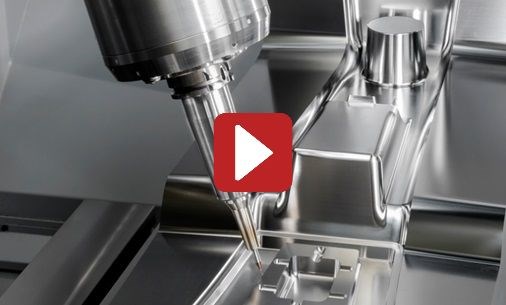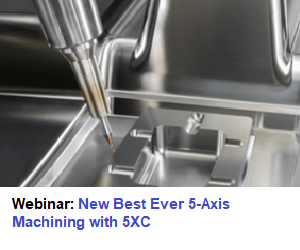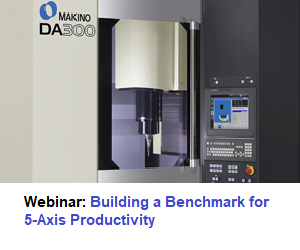Next Generation of Five-Axis Machining Is Here
Sponsored ContentSeveral technologies are converging to take five-axis machining to the next level. Mold and die makers will benefit from more capable machining centers, milling tools and CAD/CAM systems that are rendering five-axis machining remarkably more productive, yet easier to own and operate.
Share
Five-axis machining technology has grown increasingly capable over the years, but there still have been drawbacks that made some shops think it was out of their reach. And to be fair, there have been inherent limitations that kept five-axis technology from achieving its potential from a pure machining productivity perspective.

That’s changing rapidly with advancements in machine tool technology, as well as with enabling technologies such as cutting tools and CAD/CAM software. Combined, these advancements render five-axis machining processes that are astonishingly more productive than that of a few years ago. Though perhaps counterintuitive to some, a more expensive machine and cutting tool will result in the lowest cost per part, and sometimes by a lot.
The combination of these technologies enables faster generation of smooth and accurate 3D surfaces in difficult materials, and increased tool life. Mold and die makers will likely be the first to recognize the benefits, but these process improvements also serve a wide range of 3D applications such as orthopedics and aerospace.
Greg Pozzo from Makino discusses the advantages of 5XC and how it's changing the game for five-axis machining.
The Machine Tool
Historically, five-axis machine design has essentially used a 3+2 configuration, with the “3” being a three-axis machining center and the “+2” being a rotary/tilt table or head. That’s not to say you couldn't contour with all five axes, but that “+2” was typically the weak link from a machining perspective in both positioning speed and accuracy. You’d typically see + 3 - 5 arc sec. in positioning accuracy and 30 to 50 rpm in speed.
Take a deeper dive in the newest five-axis machining technology with
this free webinar.
Makino’s D200Z is a good example of the newest five-axis machining technology. It is the result of the machine tool builder’s “5XC” program that addresses all aspects of the five-axis machining process. With direct drive servo motor technology on a tilt/trunnion table, this machine can achieve positioning accuracy and repeatability of + 2 arc. sec. on the tilt and + 1 arc. sec. on the rotary axis, and at 100 to 150 rpm.
Overall machine performance is about more than just the 4th and 5th axes. In the primary axes, the machine can achieve a 2,400-ipm feed rate with 1.5 acceleration in the X and Y axes, and 2 G in Z, and all at higher precision than earlier technology. It’s a combination of advancements in the motion control system that makes this kind of performance possible including:
- More responsive servo motors that can be more tightly tuned
- Higher resolution (0.0125 in.) axis position feedback scales
- Higher thermal stability with coolant running through ballscrews, bearings and other components
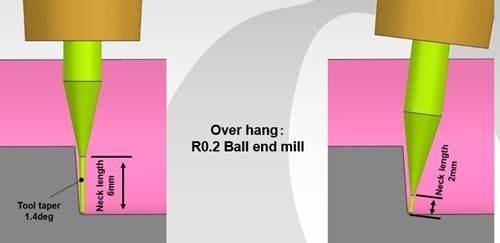
Three-axis machining forces the use of long tools to reach certain
workpiece features. Five-axis machining facilitates a more rigid tool and
toolholder set, allowing for more aggressive machining.
Just as critical is upgraded control technology that does much more than process program blocks faster. It also can automatically smooth 3D tool paths, “know” the true position of the entire cutting tool and workpiece to provide real-time collision avoidance, and even dynamically map and compensate automatically for small tool position errors caused by workpiece inertia.
Click here for more on the Makino D200Z five-axis machining center.
The Cutting Tools
Five-axis control opens up new opportunities to better utilize cutting tools. Conversely, new cutter geometries are emerging that better utilize five-axis mills. Even with a common ballnose end mill, you’ll get much better utilization of the cutting edges and higher material removal by tilting the tool and cutting with the outer radius of the ball. Five-axis machining makes that possible.

Target ideal contact point of the tool to achieve the best cutting condition. On left, trying to cut with tip of the tool where there isn’t any velocity. By tipping the tool you use a larger portion of the of the diameter to get good cutting conditions.
Two more recent developments can deliver even greater gains in productivity:
Multi-Flute End Mills – This one is simple math. Having more flutes on a cutting tool lets you maintain higher speeds and feeds simply because you have more edges in play. Makino has proven this out in tests with six-flute end mills.
Moreover, the extra flutes provide more cutting surface on a given tool, which results in longer tool life. Altogether, these advantages result in much higher metal removal rates, better surface finish and lower overall cost.
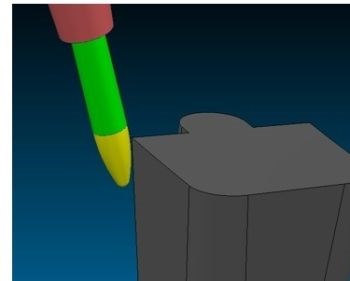
Barrel-Shaped Tools – Barrel-shaped cutters are designed specifically for five-axis machining. These cutters have contoured profiles that enable wider cutting contact with a contoured workpiece surface, almost like a super-large ball nose end mill. Coming in several configurations, perhaps the most common is a large radius tool that curves down to a small radius at the tip.
The biggest advantage of this tool is that it provides an equivalent or better surface finish with larger stepovers, resulting in fewer passes required to machine a 3D surface. Then, with the small radius tip of the tool, you can get into tight corners. Not only can you do more with a single tool, it results in continuous machined surfaces with significant reductions in blending issues.
Barrel-shaped milling tools also come in multi-flute configurations. Add it all up and you get fewer tool passes while achieving better surface quality, faster feed rates, fewer tool changes and a more productive cutting process.
Here are two specific examples of how these multi-flute and barrel-shaped tools make a five-axis machining process more productive:
This video demonstrates how the use of multi-flute and barrel-shaped cutters can dramatically reduce cycle times.
CAD/CAM for Five-Axis Machining
While seeing is believing, it’s reasonable to ask how easy it is to generate the tool paths shown in these demos. Fortunately, commercial CAM systems, such as Autodesk’s PowerMill, Mastercam and Open Mind Technology’s hyperMILL, are evolving to make the application of 5XC technology easier, safer and more productive.
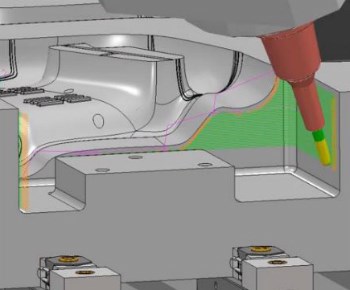
Tool paths can be programed first in standard three-axis mode, and then the
five-axis moves are added as the system checks for interference with other workpiece features.
CNC programming has historically caused bottlenecks in five-axis machining because of the complexities of the surface geometry and the many tool vectors. However, as CAM vendors continue to add features, programming is becoming more adept at creating efficient tool paths in less time. For example, some systems layer five-axis features on top of a more familiar three-axis functionality. You begin by generating a three-axis program as normal, and then add in the five-axis moves where the tool is tilted away from adjacent surfaces and avoiding collisions.

CAM systems have also evolved to support multi-flute cutters and the barrel-shaped tools. You can program in the tool shape so that the system can automatically generate tool paths with larger stepovers while maintaining or improving the machining tolerance to the surface model. The result is less need for blending, matching and stitching.
One of the big challenges of five-axis machining is avoiding collisions. Program validation software such as CGTech’s Vericut goes a long way to reduce that risk by simulating the entire cutting process to identify any inadvertent cutter or toolholder collisions with adjacent workpiece surfaces. Something the software may not know in the real machining process, however, is actual tool length and position of the workpiece (on a tilt/trunnion table). For that, Makino can take the information from the Vericut simulation and enter it into the machine control to alert operator of any potential collisions.
Add it Up
These enhanced CAM features substantially reduce the time it takes to go from a CAD file to a proven five-axis part program. When lead time is critical, such as die/mold work, that’s a huge competitive advantage. When you add it all up, today’s five axis machining technology can deliver:
- Significantly reduced cycle times
- Smoother, more accurate machined surfaces
- Less need for secondary processes – EDM and benching
- Lower tooling costs
Simply, today’s more capable five-axis technology delivers a much better return on your investments in equipment, tooling, software and people. That adds up to more profitable jobs, and ultimately a more successful business.
Look here for more information on D200Z five-axis machining center from Makino.
